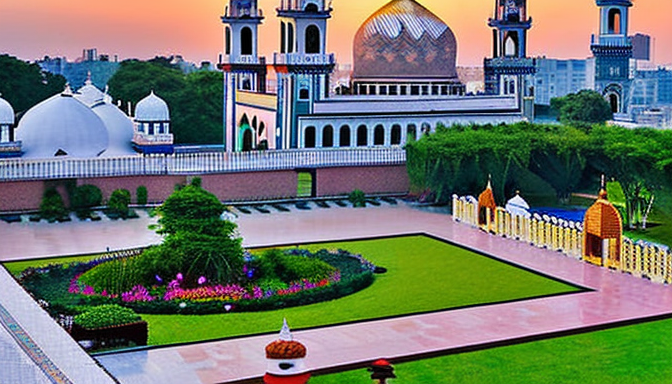Karachi, a bustling metropolis, is not just a hub of commerce and culture; it is also home to some of the most stunning mosques in the world. These sacred spaces are more than just places of worship; they are architectural marvels that reflect the city’s rich history and diverse culture. Imagine walking through the vibrant streets of Karachi, only to be greeted by the towering minarets and intricate designs of these mosques. Each one tells a story, a narrative woven through time and faith.
From the traditional Islamic designs that echo centuries-old craftsmanship to modern structures that embrace contemporary aesthetics, Karachi’s mosques showcase a blend of styles. For instance, the stunning Masjid-e-Tooba, known for its grand dome, stands as a symbol of unity and architectural brilliance. On the other hand, the historic Frere Hall mosque reveals the colonial influences that shaped the city. Each mosque is like a chapter in a book, revealing layers of Karachi’s identity.
But it’s not just about bricks and mortar. These mosques play a vital role in the community. They are places where people gather, share stories, and build connections. They foster a sense of belonging, a spiritual home for many. When you step inside, you can feel the energy, the prayers, and the hopes of countless individuals. Karachi’s mosques are indeed a testament to the city’s enduring spirit and rich architectural identity.
Architectural Styles of Karachi’s Mosques
Karachi is a city where the past and present collide, especially in its mosques. These sacred spaces are not just places of worship; they are also stunning examples of architectural diversity. Each mosque tells a story, reflecting the city’s rich cultural tapestry. From the intricate designs of traditional Islamic architecture to the sleek lines of modern structures, Karachi’s mosques are a feast for the eyes.
Take, for example, the iconic Frere Hall Mosque. Its Victorian-era architecture stands in stark contrast to the more traditional mosques like the Masjid-e-Tooba, which boasts a magnificent dome that seems to touch the sky. The blend of styles is fascinating:
- Traditional Islamic: Features intricate tile work, calligraphy, and stunning domes.
- Modern Interpretations: Emphasizes clean lines and innovative materials, often incorporating glass and steel.
- Colonial Influences: Reflects the British architectural style, seen in structures like the Shah Jahan Mosque.
These mosques are more than just buildings; they are landmarks of community identity. They serve as gathering places, where people come together for prayers and celebrations. The architecture invites you in, making you feel both welcome and inspired. Next time you stroll through Karachi, take a moment to appreciate these architectural gems. They are not just bricks and mortar; they are the heart of the city.

The Spiritual Significance of Mosques
In Karachi, mosques are more than just buildings; they are the heartbeats of the community. These sacred spaces offer a refuge, a place where people come together to connect not only with their faith but also with each other. Imagine stepping into a mosque, feeling the coolness of the marble underfoot, and hearing the soft whispers of prayer. It’s a moment that transcends the ordinary.
Each mosque tells a story. From the majestic Frere Hall Mosque to the intricate designs of the Masjid-e-Tooba, these structures reflect the city’s rich cultural heritage. They stand as symbols of hope and unity, inviting everyone to gather and share in the experience of worship. The architecture often incorporates elements that hold deep spiritual meaning, like the use of light and space to create an atmosphere of tranquility.
Moreover, mosques play a vital role in community life. They host events, celebrations, and educational programs, making them hubs of activity. For many, the local mosque is where friendships blossom and support systems are built. It’s a place where stories are shared, and traditions are passed down through generations. In a bustling city like Karachi, the mosque serves as a reminder of the importance of community.
In essence, Karachi’s mosques are not just places of worship; they are living monuments to the city’s spiritual journey. They embody the connection between the divine and the everyday, making them indispensable to the fabric of life in this vibrant metropolis.
Frequently Asked Questions
- What architectural styles can be found in Karachi’s mosques?
Karachi’s mosques showcase a fascinating blend of architectural styles. You can find traditional Islamic designs featuring intricate tile work and domes, alongside modern interpretations that incorporate contemporary elements. This diversity reflects the city’s rich cultural heritage and the artistic expressions of its builders.
- How do Karachi’s mosques contribute to the community?
These mosques are more than just places of worship; they serve as community hubs where people gather for prayers, celebrations, and social events. They play a vital role in fostering a sense of belonging and cultural identity among the diverse population of Karachi.
- Are there any famous mosques in Karachi?
Absolutely! Karachi is home to several renowned mosques, such as the beautiful Faisal Mosque and the historic Shah Jahan Mosque. Each of these mosques has its own unique story and architectural charm, making them must-visit landmarks for both locals and tourists alike.
- Can non-Muslims visit Karachi’s mosques?
Yes, many mosques in Karachi welcome visitors from all backgrounds. However, it’s important to respect local customs, dress modestly, and follow any guidelines provided by the mosque staff to ensure a respectful experience.